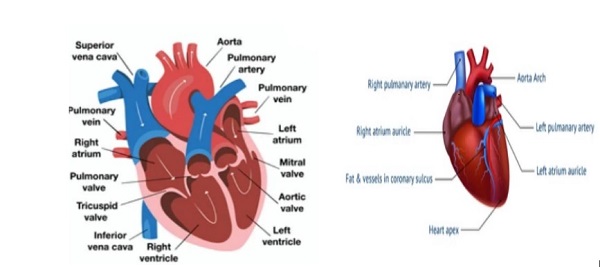The contraction of two atriums is promptly accompanied by the contraction of two ventricles, resulting in a continuous blood flow throughout the body. The circulatory mechanism may be summarized as follows:
The blood mixes with oxygen as it flows through the capillaries of the lungs. Four pulmonary veins carry this oxygenated blood from the lungs to the left auricle.
The left atrium contracts, which forces oxygenated blood into the left ventricles.
The left ventricle pushes blood into the aorta, the largest blood channel in the body. It provides oxygen-rich blood to the various bodily regions.
Through capillaries, the oxygenated blood is delivered to all of the body's organs.
The deoxygenated blood from different organs of the body reaches the right atrium through the capillaries and veins.
Through the opening valve, the right atrium compresses and forces deoxygenated blood into the right ventricles.
The right ventricles push impure blood into the pulmonary arteries, which carry the blood to the right and left lungs for purification.
By exhaling CO2, the lungs remove waste products and the blood collects oxygen for reoxygenation. The valves on both sides of the heart govern the flow of blood from one chamber to the next.
This cycle continues to circulate continually throughout the day and night, even as we sleep.
Excretion
The process by which a living creature eliminates waste products created by its cells is known as excretion. When our body metabolizes food, water, and air, it generates byproducts or undesirable compounds. These are known as waste products.
These waste products are hazardous or harmful and cause bodily damage. If these dangerous compounds come into contact with blood, they may turn lethal and kill the organism. Therefore, waste must be eliminated from the body for a person to remain healthy.
CO2, urea, perspiration, etc., are examples of the byproducts of the many cellular activities. These wastes are eliminated from the body by organs such as the lungs (CO2), kidneys (urea), and sweat glands (sweat). These biological components or organs that are engaged in excretion are known as the excretory system.
Human Excretory System
Urea is the most abundant waste product in the human body, and it is created as a byproduct of the liver's breakdown of unneeded dietary proteins. This material is toxic and must be eliminated from the body. Urine is eliminated from the blood by the kidney. Consequently, the kidney is the primary excretory organ in the human body. When urea and other undesirable ions dissolve in water, they produce urine, a yellowish liquid waste.
It is composed of 2.5% urea, 2.5% waste salts, and 95% water. A typical adult excretes between 1.1 and 1.8 liters of urine every day. The excretory system collects and eliminates urine. The human excretory system includes two kidneys, two ureters, a bladder, and a urethra.
Did you know?
William Harvey (AD 7578-1657) was an English physician who discovered the circulation of blood. The prevalent belief at the time was that blood circulates through the body's vessels. Harvey was mocked and labeled a propagandist for his opinions. The majority of his patients died. However, Harvey's theory concerning circulation was widely acknowledged as a biological truth before his death.
Kidneys
Kidneys are known as "magic filters", which are bean-shaped organs, located slightly above the waist at the back of the human body. It is around 4 inches in length and is colored brick red. It has an abundance of blood vessels. The kidney may filter the blood of undesirable chemicals. Each kidney has thousands of microscopic filters known as nephrons. When blood carrying urea and other waste salts passes through these nephrons, the blood is filtered and urea is removed, leaving the kidney with salts and urine.
The urine produced by each kidney is subsequently transported to the urinary bladder through the ureter (a tube-like structure that links the kidney to the bladder). Urine is held in the urinary bladder for a period of time before being periodically expelled via the urethra. The process of urinating is known as micturition.
The entrance of the urine bladder is regulated by the muscular ring known as the bladder sphincter. This bladder sphincter relaxes when the bladder is full with pee, allowing urine to flow out.
Urine:
Humans, typically, pass about 1-1.8 liters of urine in 24 hours. A urine sample contains 95% water, 2.5% of urea, and 2.5% other types of waste products.
Sweat
Sweat is the body's liquid waste that is generated by the sweat glands in our skin. Very modest amounts of undesirable ions and urea are present in perspiration. During the warmer summer months, we perspire heavily and this evaporates from the human body. This contributes to the cooling impact on the body. The two most important roles of sweat are:
⦁ It aids in the elimination of excess water, salt, and urea from the body.
⦁ It helps to maintain our body's temperature during hot summer days.
Dioxide
During the process of cellular respiration, carbon dioxide is created as a byproduct. During respiration, food is broken down to generate energy, and CO2 is released as a byproduct. The lungs eliminate this CO2 from the body when we exhale. Consequently, the lungs also function as excretory organs for eliminating CO2 from the body.
FAQs:
Q1. Do Sponges and Hydra have a circulatory system too?
Ans. Sponges and Hydra are primitive creatures without a cardiovascular system. They are aquatic organisms; therefore, food and oxygen enter their bodies alongside the water. The water also transports CO2 and other waste products out from the body when it leaves the body.
Q2. How sweat is different from urine?
Ans. 90 percent by volume of sweat comprises of water, 1-3 percent salt, and 0.5-2 percent urea. Additionally, your perspiration includes glycerol, ammonia, lactic acid, and many trace components.
In contrast, urine is mostly composed of water (95-96 percent by volume), 2-7 percent salt, 1.8 percent urea, and 0.3 percent uric acid. The remaining 2 percent of urine is made up of a variety of different nitrogenous substances, including minor quantities of creatinine, ammonia, organic acids, and amino acids. This suggests that the components of one liter of sweat and one liter of urine are distinct!
To know more about the heart and its flow of oxygenated and deoxygenated blood through it and the filtration that happens in the kidney, check out our videos.


